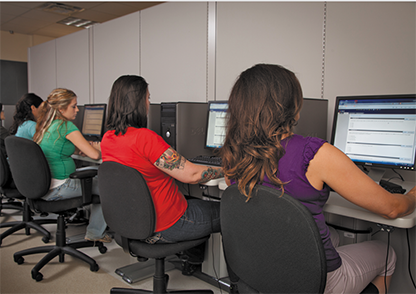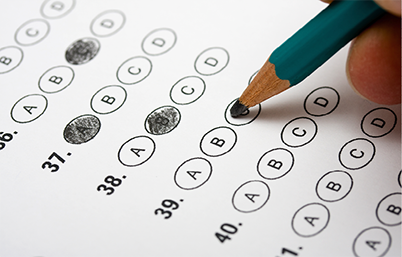16.2 Preparing for the Certification Exam
As explained in Chapter 1, each state has its own requirements for registration, licensure, and certification for practice. More than half the states have made national certification either mandatory or preferred for licensure or practice, and the number of states making this a requirement continues to grow. In states with fewer requirements, employers are often making this requirement on their own to increase their business or facility rates of medication safety and efficiency. The certification requirement is especially common in hospitals, as they desire ongoing accreditation.
The American Society of Health-System Pharmacists (ASHP) has provided a model curriculum and standards for an accredited pharmacy technician education and training program that mandates a minimum of 600 hours—including 160 hours of classroom coursework, 80 hours of laboratory training, and 360+ hours of hands-on practice site experience. A task force of the National Association of Boards of Pharmacy (NABP) has recommended that state boards of pharmacy license or register pharmacy technicians, requiring standardized guidelines for education and training.
 Pharm Fact
Pharm Fact
The ExCPT is not nationally recognized.
As noted in Chapter 1, you can pass one of two examinations to become a Certified Pharmacy Technician (CPhT). The Pharmacy Technician Certification Board (PTCB) offers the Pharmacy Technician Certification Exam (PTCE), and the National Healthcareer Association (NHA) offers the Exam for Certification as Pharmacy Technicians (ExCPT). (For a review of both, see Chapter 1.) The two exams are similar in content, though the ExCPT tends to be more geared to community retail pharmacy. For exploring more wide-ranging career options, there are some advantages to the PTCE since the PTCB is aligning it with the standards of ASHP. The PTCE requires background checks and is accepted by all 50 states as a legitimate certification for the profession. Five states specifically require PTCB certification to be eligible to practice—Arizona, Louisiana, North Dakota, Texas, and Wyoming (as of June 2019), with more moving in this direction. Hospitals and institutions tend to favor the PTCE.
 Pharm Fact
Pharm Fact
Many hospitals favor or require PTCB certification.
The PTCB’s executive director, William Schimmel, explained to an interviewer for Pharmacy Times that national certification becomes a “portable credential” that can travel from state to state and job to job. “Employers place a considerable value on certification because it demonstrates your knowledge as a technician and your commitment to your role in the pharmacy. As we see things change in the profession and advanced roles for technicians open up, certification will open a number of new opportunities.”
Certification Eligibility
Both certification exams require the applicant to be a high school graduate or to have passed the General Education Development (GED) test or some other equivalency test. You may also have achieved a foreign or alternative diploma recognized by your state and the American Association of Collegiate Registrars and Admissions Officers as indicating sufficient secondary education proficiency. If this has not yet been attained but will be in the next 60 days, you are allowed to sit for either exam. Eligibility requirements for the two national certification tests differ slightly.
PTCE Eligibility
PTCB certification requires a disclosure of all criminal and state board of pharmacy violations. Many academic pharmacy technician programs do a screening of students and also have them complete a drug screening test. As of 2020, the PTCB offers two eligibility pathways for technicians seeking certification. One is the completion of a PTCB-recognized education program. The other pathway is through equivalent work experience.
The PTCB also requires all exam certification applicants and certified personnel to be in compliance with all its policies, including its Code of Conduct, summarized in Table 16.1. The PTCB standards and expectations are outlined on its website and include following all PTCB, federal, state, local, and employer rules and laws; upholding professional standards; delivering safe medications and recognizing practice limitations in deference to the pharmacist; maintaining and respecting patient and professional confidentiality; providing truthful representation of one’s actions and credentials; following appropriate safety procedures and standards; and avoiding conflicts between patients and employers, among other standards. For more information, visit https://PharmPractice7e.ParadigmEducation.com/PTCB and its code of conduct page: https://PharmPractice7e.ParadigmEducation.com/Conduct.

A PTCB-recognized education program can help pharmacy technicians on the path to achieving certification.
Table 16.1 Code of Conduct and Ethical Expectations for Pharmacy Technicians
|
The PTCB Code of Conduct expects its certified technicians to:
Source: Pharmacy Technician Certification Board website at https://PharmPractice7e.ParadigmEducation.com/Conduct |
|
The NHA Code of Ethics expects its certified professionals to:
Source: National Healthcareer Association Certification Candidate Handbook at 6 https://PharmPractice7e.ParadigmEducation.com/NHAHandbook |
ExCPT Eligibility
In addition to the secondary education requirement, all ExCPT candidates must have completed a pharmacy technician training program from a state-recognized institution within the past five years. In lieu of this, you can have passed an employer-based academic training program that has been approved by the state board of pharmacy or have 1,200 hours of employer-supervised pharmacy-related experience within any one year of the past three years. Those with pharmacy-related training in the military are also eligible. The student must prepare a “candidate profile” and agree to an attestation statement, a statement by a witness who verifies that they observed that correct individuals put their signatures on a given document, before sitting for the exam.
The NHA also sets out a high standard of expectations for all its allied health certifications in its NHA Code of Ethics, and it further outlines specifics of behaviors expected for pharmacy technicians to attain and maintain certification. These include, among many other standards, that pharmacy technicians “assist and support pharmacists in the safe and efficacious and cost effective distribution of health services and healthcare resources,” “continually enhance professional knowledge and expertise,” and “respect and support the patient’s individuality, dignity and confidentiality.” The list is longer and has been adapted from the American Association of Pharmacy Technicians’ Code of Ethics. For more information, go to the NHA website at https://PharmPractice7e.ParadigmEducation.com/NHA.
Preparing for the Exams
Students taking the PTCB exam are encouraged to review Certification Guidelines and Requirements: A Candidate Guidebook, which is available online. The NHA suggests that the candidate download its Candidate Handbook. Paradigm Education Solutions offers a Certification Exam Review for Pharmacy Technicians (in its most current edition), which has an extensive number of up-to-date practice exam questions and has been recommended by many instructors. Practice exams and study guides are also available from the American Pharmacists Association (APhA), The Pharmacy Technician Workbook & Certification Review, and other commercial sources.
Both the PTCB and the NHA also offer online study guides and practice exams for a fee. There are other sites that offer them as well. The purpose of the practice exams is to provide the applicant with familiarity with the content, format, and structure of the exam. Schools and other educational groups offer practice tests as well. Instructors have found that the students who take practice tests gain confidence and understanding of what to expect and do better on their exams.
Scheduling and Taking the PTCE
There are a few steps involved in scheduling to take the PTCE. First, you must apply online at https://PharmPractice7e.ParadigmEducation.com/Application1.
If the application is accepted, authorization to schedule an exam will arrive via email and be valid for 90 days. Because the test must be taken at a computer-based testing site at one of the Pearson Professional Centers or military testing centers, you must schedule with Pearson VUE via telephone at (866) 902-0593 or online at https://PharmPractice7e.ParadigmEducation.com/Application2.
 Practice Tip
Practice Tip
Many employers may pay or reimburse you for taking the PTCE or ExCPT.
Be prepared to pay the testing fee (which in 2019 was $129). A confirmation of the test date and place will be sent via email within 24 hours. Candidates who need special testing accommodations must call (800) 466-0450.
You will be given one hour and fifty minutes to complete the 90-question examination. The PTCE is organized into four domains or sections, each of which is weighted differently. Skills and knowledge from both the community and institutional settings are required to pass this examination, including basic compounding knowledge and skills. Table 16.2 details the exam content as specified by the PTCB. Out of the 90 multiple-choice questions, only 80 are scored, and each comes with four possible choices. Only one answer is correct. You should answer every question whether you are sure of the answer or not, because the final score is based on the total number of questions answered correctly rather than the percentage of correct answers. Educated guesses are encouraged. In the final 10 minutes, you will take a post-exam survey and receive your unofficial results on-site.
Table 16.2 PTCE Content
1. |
Medications 40% |
1.1 |
Generic names, brand names, and classifications of medications |
1.2 |
Therapeutic equivalence |
1.3 |
Common and life-threatening drug interactions and contraindications (e.g., drug-disease, drug-drug, drug-dietary supplement, drug-laboratory, drug-nutrient) |
1.4* |
Strengths/dose, dosage forms, routes of administration, special handling and administration instructions, and duration of drug therapy |
1.5 |
Common and severe medication side effects, adverse effects, and allergies |
1.6 |
Indications of medications and dietary supplements |
1.7* |
Drug stability (e.g., oral suspensions, insulin, reconstitutables, injectables, vaccinations) |
1.8 |
Narrow therapeutic index (NTI) medications |
1.9 |
Physical and chemical incompatibilities related to non-sterile compounding and reconstitution |
1.10 |
Proper storage of medications (e.g., temperature ranges, light sensitivity, restricted access) |
2. |
Federal Requirements 12.5% |
2.1 |
Federal requirements for handling and disposal of nonhazardous, hazardous, and pharmaceutical substances and waste |
2.2* |
Federal requirements for controlled substance prescriptions (i.e., new, refill, transfer) and DEA controlled substance schedules |
2.3 |
Federal requirements (e.g., DEA, FDA) for controlled substances (i.e., receiving, storing, ordering, labeling, dispensing, reverse distribution, take-back programs, and loss or theft of) |
2.4* |
Federal requirements for restricted drug programs and related medication processing (e.g., pseudoephedrine, Risk Evaluation and Mitigation Strategies [REMS]) |
2.5 |
FDA recall requirements (e.g., medications, devices, supplies, supplements, classifications) |
3. |
Patient Safety and Quality Assurance 26.25% |
3.1 |
High-alert/risk medications and look-alike/sound-alike (LASA) medications |
3.2 |
Error prevention strategies (e.g., prescription or medication order to correct patient, Tall Man lettering, separating inventory, leading and trailing zeros, bar code usage, limited use of error-prone abbreviations) |
3.3* |
Issues that require pharmacist intervention (e.g., Drug Utilization Review [DUR], adverse drug event [ADE], OTC recommendation, therapeutic substitution, misuse, adherence, post-immunization follow-up, allergies, drug interactions) |
3.4 |
Event reporting procedures (e.g., medication errors, adverse effects, and product integrity, MedWatch, near miss, root-cause analysis [RCA]) |
3.5* |
Types of prescription errors (e.g., abnormal doses, early refill, incorrect quantity, incorrect patient, incorrect drug) |
3.6 |
Hygiene and cleaning standards (e.g., handwashing; personal protective equipment [PPE]; cleaning counting trays, countertop, and equipment) |
4. |
Order Entry and Processing 21.25% |
4.1* |
Procedures to compound non-sterile products (e.g., ointments, mixtures, liquids, emulsions, suppositories, enemas) |
4.2* |
Formulas, calculations, ratios, proportions, alligations, conversions, Sig codes (e.g., b.i.d., t.i.d., Roman numerals), abbreviations, medical terminology, and symbols for days’ supply, quantity, dose, concentration, dilutions |
4.3* |
Equipment/supplies required for drug administration (e.g., package size, unit dose, diabetic supplies, spacers, oral and injectable syringes) |
4.4* |
Lot numbers, expiration dates, and National Drug Code (NDC) numbers |
4.5 |
Procedures for identifying and returning dispensable, non-dispensable, and expired medications and supplies (e.g., credit return, return to stock, reverse distribution) |
*Some or all of this statement reflects calculation-based knowledge. |
|
Scheduling and Taking the ExCPT
To schedule your ExCPT, you also need to apply online at https://PharmPractice7e.ParadigmEducation.com/Application3.
Once you receive approval to schedule, you can schedule at your school if it is an NHA-affiliated school offering the test or schedule the date at the nearest PSI Testing Center (PSI is an international company specializing in testing). Call (800) 733-9267 or schedule online at https://PharmPractice7e.ParadigmEducation.com/Application4.
The NHA test fee (which in 2019 was $117) may be accompanied by additional PSI fees. NHA-affiliated schools often include the fee for the exam in the costs of the school program. If special testing accommodations are needed, you must fill out a form at the NHA website: https://PharmPractice7e.ParadigmEducation.com/Application5.

Both the PTCE and the ExCPT are offered at computer testing sites.
Though the ExCPT can also be taken as a paper test at some sites (bring two number 2 pencils and an eraser), it is generally offered as a computer-based examination. The ExCPT seeks to ensure that you can properly assist pharmacists in dispensing medications by receiving and processing prescriptions from patients and from doctors’ offices, establishing and maintaining patient records, accurately measuring medication amounts, packaging and labeling the medications, accepting payments and processing insurance claims, and managing inventory. Test takers are given two hours and ten minutes to complete the 100 multiple-choice questions (and 20 pretest questions) from a large test bank. The content for the graded exam is weighted approximately as follows:
25 questions on regulations (including controlled substances) and technician duties
15 questions on drugs and drug products (Top 200 Rx and Top 100 OTC products)
45 questions on the dispensing process (including calculations and compounding)
15 questions on medication safety and quality assurance
A detailed breakdown of each of these categories can be downloaded under the ExCPT Test Plan at https://PharmPractice7e.ParadigmEducation.com/TestPlan.
Taking the Exams
The night before you take the test, get a good night’s sleep, and have something to eat in the morning before the test. Don’t be afraid of test-taking stress. It is not a bad sign, but it shows instead that your body and mind are recognizing a challenge and preparing to meet it. Use the sense of stress to motivate yourself to study ahead of time, and understand that stress is a natural part of the process and should not be feared but applied to help you focus.

Both the PTCE and ExCPT are offered by computer. For a paper exam, students must go to a special site or make a request for accommodation.
On the day of the scheduled exam, you should arrive at least 30 minutes early (having made sure ahead of time that you have the directions and know where to park). Be sure to bring valid identification, which is defined as an unexpired, government-issued ID with photograph and signature. Common valid IDs include a driver’s license, a passport, or a military ID. If the identification does not include a signature, a secondary ID will be required. This could be a Social Security card, a credit/debit/ATM card, or an employee/school ID.
Personal items will be stored in a provided locker. No electronic devices such as cell phones, tablets, or calculators are allowed in the testing room. Calculators will be provided online or will be available upon request from the testing monitor. The applicant must agree to all PTCB or NHA testing policies prior to starting the appropriate exam.
Grading of the PTCE
As noted, before leaving the test site, you will receive unofficial results, with the official results being emailed to you and/or posted on the PTCE website in two to three weeks. According to the PTCE scoring blueprint, the range of possible scores is 1,000 to 1,600, and 1,400 or higher is passing. The PTCB reports that, since its inception, the test has been rigorous, with numerous math and drug questions—an average of 57% of the scored exams qualified the test taker for certification. With the new ASHP standards, the test has become even more rigorous. You can take it four times, though you must wait 60 days between attempts (you must reapply and pay the fee each time). The official certificate that recognizes you as a Certified Pharmacy Technician (CPhT) will arrive in the mail in four to six weeks.
Grading of the ExCPT
The ExCPT is immediately graded, and students at the PSI testing centers find out whether they passed or not. The scores are confidentially posted on the NHA website within two days. The scores range from 200 to 500, converted from the raw test scores and weighted question system. A passing score is 390 or above. Those who successfully pass the ExCPT will receive a formal CPhT certificate and wallet card within 7 to 10 business days of the exam date. Candidates who do not pass the ExCPT are allowed to retake the exam after four weeks. You can log into your account at the NHAnow.com website for a diagnostic of your test and recommendations for improvement.
Recertification
Recertification is required by both the PTCB and NHA every two years to maintain certification status. To be recertified, you must earn 20 hours of credit in pharmacy-related, approved continuing education (CE). Both ExCPT and PTCB recertification requires one hour of continuing education in medication or patient safety and one hour in pharmacy law. Acceptable CE topics include drug distribution, inventory control, managed health care, drug products, therapeutic issues, patient interaction, communication, interpersonal skills, pharmacy operations, prescription compounding, calculations, pharmacy law, preparation of sterile products, and drug repackaging.
 Pharm Fact
Pharm Fact
For PTCB recertification, 10 credits may be related college courses but 10 must be pharmacy specific, with 1 credit in medication safety and 1 credit in pharmacy law. Free credits can be found at Power Pak C.E. For registration, go to https://PharmPractice7e.Paradigm.Education.com/Powerpak.
Certificates of participation must be obtained for each CE program. Pharmacy-related continuing education may be provided by professional organization meetings and websites, employers, and professional journals. In some cases, applicable college courses where students received a grade of C or better may also be eligible for CE credit.